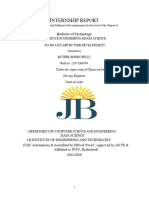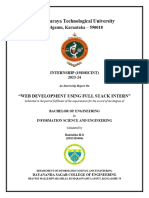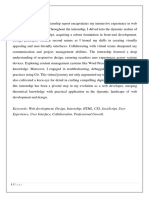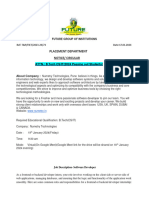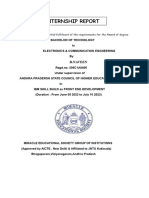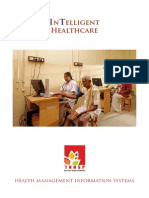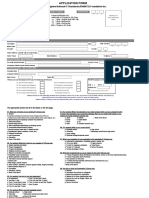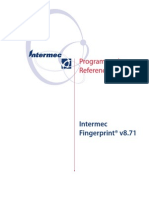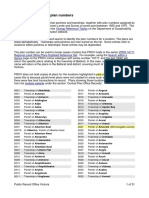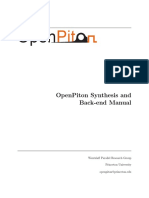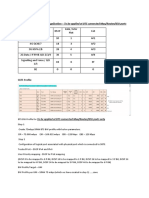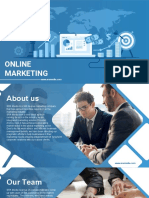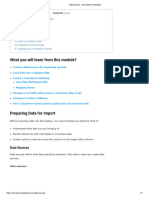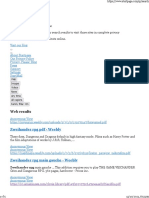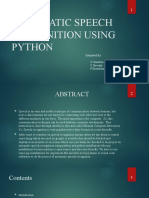Final Report
Uploaded by
pawarsambhaji235Final Report
Uploaded by
pawarsambhaji235Front-end Development
INDUSTRY INFORMATION
Innomatics Research Labs is a pioneer in “Transforming Career and Lives” of individuals in the
Digital Space by catering advanced training on NASSCOM Future Skills Prime Certified Data
Science, Machine Learning, Artificial Intelligence (AI), Full Stack Development, Amazon Web
Services (AWS), DevOps, Microsoft Azure, Big data Analytics, and Digital Marketing. We are
passionate about bridging the gap between learning and real-time implementation, so
empowering individuals to be industry-ready and help firms in reaping huge benefits is our
primary goal.
We work greatly on this motto; so we let a trainee work hands-on, explore challenges, and
experience real-time business cases. We have been awarded as the Best Training Institute in
Hyderabad by Times Of India for our relentless hard work, practical training approach, and
making individuals skillful. As an authorized “Training Partner with NASSCOM Future Skills
Prime,” we strive to make individuals learn not just algorithms, but also business case studies
and challenges. Hackathons, workshops, and meetups are conducted on a timely basis to
improve effectiveness and productivity. Having a dedicated placement vertical which helps
trainees conquer the business world, solve the complexities. Innomatics is supporting over 100
companies in finding the best candidate, which can upskill the business requirements and foster
growth. Our vision is to invade and make India a Hub for Artificial intelligence and analytics.
Apart from being the most credible education institute for career transformation, we aim to
become the best training institute with experts from different domains like Banking, Insurance,
Retail, Health Care, and Manufacturing. Communicating with the industry experts and
explaining the value data science brings to the Organization for better decision making;
demonstrate how methodologies can be applied and optimize opportunities, innovate new and
better tools.
1 JSPM’s ICOER Department of E&TC
Front-end Development
CERTIFICATE OF INTERNSHIP
2 JSPM’s ICOER Department of E&TC
Front-end Development
ABSTRACT ABOUT INTERNSHIP
This internship in Front-end Development provided extensive hands-on experience in designing,
developing, and deploying dynamic, scalable web applications. This report provides an overview
of internship experience in front-end development, focusing on the technologies, methodologies,
and challenges encountered. During the internship, I worked with modern web development
frameworks such as React.js, enhancing my skills in building responsive and interactive user
interfaces. I gained hands-on experience with HTML, CSS and JavaScript to create visually
appealing and functional web applications.
Additionally, I explored state management, API integration, and performance optimization to
improve the efficiency and usability of web applications. The internship also exposed me to
version control systems like Git, collaborative development using Agile methodologies, and
debugging techniques. Overcoming challenges such as cross-browser compatibility and responsive
design further strengthened my problem-solving abilities.
Through this internship, I developed a deeper understanding of front-end development principles
and industry best practices, preparing me for future roles in web development. This report
highlights key learnings, contributions, and reflections on my professional growth in front-end
development.
3 JSPM’s ICOER Department of E&TC
Front-end Development
AIM OF INTERNSHIP
The aim of this internship in Front-end Development is to gain comprehensive hands-on
experience in both front-end technologies, fostering a deeper understanding of web application
development. Through this internship, I intend to enhance my proficiency in front-end
technologies such as HTML, CSS, and JavaScript which are essential for creating responsive and
user-friendly interfaces. The primary aim of this front-end development internship was to gain
practical experience in designing and developing user-friendly, responsive, and interactive web
applications. The internship focused on enhancing my proficiency in front-end technologies such
as HTML, CSS, JavaScript and React.js.
Through this internship, I aimed to:
Strengthen my understanding of modern front-end frameworks and libraries.
Develop skills in creating dynamic and visually appealing web interfaces.
Gain hands-on experience with version control systems like Git and development
workflows.
Learn to optimize web performance and ensure cross-browser compatibility.
Understand the importance of responsive design and accessibility in web development.
By the end of the internship, I sought to apply these skills to real-world projects, enhance my
problem-solving abilities, and prepare for a professional career in front-end development.
The internship will provide an opportunity to work on real-world projects, where I can apply my
theoretical knowledge to solve practical problems. I am eager to learn about the software
development lifecycle, including requirements gathering, system design, coding, testing, and
deployment. This experience will also help me understand the importance of version control
systems like Git, agile methodologies, and collaborative tools that are vital in a professional
development environment.
Moreover, I aspire to develop strong problem-solving and debugging skills, as well as improve my
ability to write clean, efficient, and maintainable code. Working alongside experienced developers
will offer valuable mentorship, exposing me to best practices, design patterns, and advanced
programming concepts. Ultimately, this internship will serve as a crucial step toward becoming a
proficient front-end developer, equipping me with the skills and knowledge required to contribute
effectively to any development team.
4 JSPM’s ICOER Department of E&TC
Front-end Development
OBJECTIVE OF INTERNSHIP
The objective of this internship is to gain extensive hands-on experience in Java Full Stack
Development by integrating theoretical knowledge with real-world applications. I aim to develop
a solid foundation in front-end technologies such as HTML, CSS, and JavaScript, which are critical
for building interactive, responsive, and visually appealing user interfaces. Through practical
projects, I seek to understand how to create dynamic web pages, manage user interactions, and
enhance the overall user experience.
The objective of the front-end development internship was to gain practical knowledge and hands-
on experience in building dynamic web applications. This included mastering essential
technologies, improving design and development skills, understanding best practices, and working
in a team-oriented development process. The internship helped bridge the gap between theoretical
knowledge and real-world application, preparing me for professional roles in front-end
development.
This internship will provide the opportunity to work on real-world projects, allowing me to apply
problem-solving and critical thinking skills to develop solutions for complex challenges. I aim to
improve my debugging techniques, optimize code performance, and understand how to handle
errors and exceptions effectively.
Moreover, I hope to gain exposure to industry-standard tools and practices, such as version control
systems (Git), collaborative development environments, and agile methodologies. Working in a
team setting will help me improve my communication, teamwork, and project management skills,
which are crucial in any professional environment.
Through continuous learning and hands-on experience, I aspire to become a proficient front-end
developer, capable of designing, developing, and deploying end-to-end web applications. This
internship will not only enhance my technical competencies but also prepare me for future
challenges in the rapidly evolving field of software development.
5 JSPM’s ICOER Department of E&TC
Front-end Development
ROLE AND DESIGNATION DETAILS ASSIGNED IN INTERNSHIP
PROGRAMME, MENTION THE DURATION OF INTERNSHIP
PROGRAMME ALSO.
During my internship as a Front-end Development Intern from 27th January 2025 to 27th
February 2025, I was assigned the role of contributing to the development and enhancement of
web applications, focusing on front-end technologies. I developed responsive user interfaces using
HTML, CSS, and JavaScript, creating dynamic, user-friendly designs that improved user
engagement and accessibility. During this period, I worked on various projects, gaining valuable
practical experience and improving my technical and problem-solving skills in front-end
development. I was also responsible for ensuring cross-browser c During my internship as a Front-
end Development Intern from 27th January 2025 to 27th February 2025, I was assigned the
role of contributing to the development and enhancement of web applications, focusing on front-
end technologies. I developed responsive user interfaces using HTML, CSS, and JavaScript,
creating dynamic, user-friendly designs that improved user engagement and accessibility. During
this period, I worked on various projects, gaining valuable practical experience and improving my
technical and problem-solving skills in front-end development. I was also responsible for ensuring
cross-browser compatibility, improving website accessibility, and following UI/UX best practices.
Throughout the internship, I gained hands-on experience in debugging, troubleshooting, and
enhancing the overall functionality of web applications. Throughout the internship, I collaborated
with cross-functional teams, participated in code reviews, and adopted version control tools like
Git for effective code management. This experience not only enhanced my technical skills but also
improved my problem-solving abilities, teamwork, and understanding of the software
development lifecycle. Overall, the internship provided me with valuable exposure to real-world
development processes, preparing me for a successful career in front-end development.
6 JSPM’s ICOER Department of E&TC
Front-end Development
DESCRIBE/DEPICT/ELABORATE THE CONTENTS OF
INTERNSHIP PROGRAMME THAT STUDENT HAS UNDERWENT
THROUGH FROM DAY ONE TO LAST DAY.
During my internship as a Front-end Development Intern from 27th January 2025 to 27th February
2025, I underwent a comprehensive learning experience that covered both theoretical and practical
aspects of front-end development. The program was structured to provide hands-on exposure to
key technologies such as HTML, CSS, JavaScript, and React.js along with real-world project
development and collaboration with professional teams.
Day 1: The internship began with an orientation session where I was introduced to the company’s
work culture, policies, and the overall structure of the internship program. This was followed by
an introduction to the technologies I would be working with, including a refresher on HTML, CSS,
JavaScript. I also familiarized myself with the development environment, tools like Git for version
control, and the basics of agile methodologies.
Week 1: The focus shifted to front-end development, where I learned to build responsive web
pages using HTML, CSS, and JavaScript. I was given a knowledge about git and GitHub
repositories about how to create and push the repositories. Simultaneously, I began working on
small tasks like developing a budget tracker website using HTML.
Week 2: In the second week, I dived deeper into React by building reusable components and
working with state management. I learned the javascript and solved some problem statement given
as a task using HTML support. I also learned about CSS frameworks to enhance styling efficiency.
During this time, I was told a task to build a shopping cart website using HTML, CSS and
Javascript.
Week 3: By the third week, my tasks became more challenging as I explored advanced concepts,
including DOM Manipulation. Under the guidance of my industry mentor. I worked on a task
named to-do list using react. I was also assigned to work on the cloning website task. I started
working on my final project of a coffee shop website where the requirements were explained to
me by the mentor.
Week 4: The internship concluded with a project presentation where I showcased the applications
I developed, explained my role, and discussed the technologies I used. I also received feedback
from mentors, highlighting areas of improvement and strengths. Additionally, I submitted all the
necessary documentation, including project reports and code repositories.
Throughout the internship, I gained valuable technical knowledge, improved my problem-solving
skills, and developed a strong understanding of the software development lifecycle. This
experience has prepared me to take on future challenges in front-end development with confidence.
7 JSPM’s ICOER Department of E&TC
Front-end Development
OUTCOME OF INTERNSHIP PROGRAM
Outcomes of my Front-end Development Internship from 27th January 2025 to 27th
February 2025 were both technically and professionally enriching, providing me with a solid
foundation in front-end development and preparing me for future career opportunities. The front-
end development internship was a valuable learning experience that enhanced my technical
and professional skills. Over the course of four weeks, I gained hands-on experience in building
and optimizing web applications using modern front-end technologies. The key outcomes of the
internship are:
1.Proficiency in Front-End Technologies – Improved skills in HTML, CSS, JavaScript, and
React.js, along with experience in using frameworks like Tailwind CSS and Material-UI.
2.Component-Based Development – Learned to design reusable and modular React components,
ensuring efficient and scalable UI development.
3.State Management & API Integration – Gained practical knowledge of React Context API
and Redux for managing application state, and Axios for fetching and handling API data.
4.Responsive & Accessible Design – Developed mobile-friendly interfaces using CSS Flexbox,
Grid, and media queries, while incorporating ARIA attributes for better accessibility.
5.Performance Optimization – Implemented lazy loading, memoization, and code-splitting
techniques to improve app performance.
6.Version Control & Collaboration – Worked with Git and GitHub, following best practices in
branching, committing, and resolving merge conflicts in a collaborative team environment.
7.Debugging & Problem-Solving – Improved debugging skills by troubleshooting UI issues,
handling CORS errors, and resolving state-related bugs.
8.Deployment & CI/CD – Gained experience in deploying applications using Netlify, and
understood CI/CD pipelines for automating builds and testing.
9.Soft Skills & Teamwork – Enhanced communication and problem-solving skills through active
participation in team meetings, sprint reviews, and code reviews.
Overall, this internship provided a solid foundation in front-end development, strengthened my
ability to work in a team, and prepared me for real-world web development projects.
8 JSPM’s ICOER Department of E&TC
Front-end Development
BRIEF ABOUT SKILLS AND TECHNIQUES LEARNED THROUGH
PROGRAMME.
During my Front-end Development Internship from 27th January 2025 to 27th February
2025, I acquired a comprehensive set of technical skills and techniques that enhanced my
proficiency in front-end development, including modern frameworks and technologies.
Front-end Development Skills:
I learned to design and develop responsive, interactive web pages using HTML for structuring
content, CSS for styling, and JavaScript for adding dynamic functionality. I gained hands-on
experience in DOM manipulation, event handling, and creating responsive layouts that adapt to
different screen sizes. Additionally, I explored React.js, learning to build reusable UI components,
manage state using hooks, and create dynamic single-page applications (SPAs) for better
performance and user experience.
Responsive Web Design: Developed mobile-friendly applications using CSS Flexbox, Grid, and
media queries to ensure cross-device compatibility.
Git & GitHub: Mastered version control, following best practices for branching, committing, and
collaborating in a team environment.
React.js & Component-Based Development: Learned to build reusable, modular, and scalable
UI components for efficient web development.
State Management: Implemented Context API and Redux for managing complex application
states across components.
Version Control and Collaboration: I became proficient in using Git for version control,
learning to manage code repositories, track changes, and collaborate effectively with team
members. This experience highlighted the importance of version control in maintaining code
quality and facilitating teamwork in professional development environments.
Agile Methodologies and Team Collaboration: I gained exposure to agile development
practices, participating in daily stand-ups, sprint planning, and code reviews. This helped me
understand the value of iterative development, continuous integration, and effective
communication within cross-functional teams.
9 JSPM’s ICOER Department of E&TC
Front-end Development
Problem-Solving and Debugging:
The internship strengthened my problem-solving skills, teaching me how to identify, analyze, and
debug technical issues efficiently. I learned to use debugging tools and techniques to troubleshoot
errors, optimize code performance, and ensure application reliability.
Project Development and Deployment:
I gained hands-on experience in developing real-world projects, from system design and coding to
testing and deployment. This helped me understand the software development lifecycle, best
practices for building scalable applications, and the importance of thorough testing and
documentation.
Overall, the internship provided me with a well-rounded skill set in front-end development,
covering technologies like HTML, CSS, JavaScript, React.js preparing me to tackle complex
projects and excel in a professional software development environment.
10 JSPM’s ICOER Department of E&TC
Front-end Development
During my internship from 27th January 2025 to 27th February 2025, I successfully
developed a Coffee Shop Website Brewed Awakening as part of my hands-on project.
This system allows users to order coffee brew like espresso cappuccino and latte and also
breakfast like sandwich, pancakes and muffins. The project involved creating a responsive
user interface using HTML, CSS, and JavaScript, with dynamic features like form
validation and order confirmations. The project enhanced my skills in front-end
development, problem-solving, and team collaboration, providing real-world experience in
building functional web applications.
1) File1: index.html
<!DOCTYPE html>
<html lang="en">
<head>
<meta charset="UTF-8">
<meta name="viewport" content="width=device-width, initial-scale=2.0">
<meta http-equiv="X-UA-Compatible" content="ie=edge">
<title>Brewed Awakening - Coffee Shop</title>
<linkhref="https://fonts.googleapis.com/css2?family=Lora:wght@400;700&family=
Roboto:wght@400;700&display=swap" rel="stylesheet">
<link rel="stylesheet" href="styles.css">
</head>
<body>
<!-- Header Section -->
<header>
<div class="header-container">
<imgsrc="https://assets.onecompiler.app/43cs9ztyn/43csa7n7u/logo.jpg"
alt="Brewed Awakening Logo" class="logo">
<nav>
<ul class="nav-links">
<li><a href="#menu">Menu</a></li>
<li><a href="#about">About Us</a></li>
<li><a href="#contact">Contact</a></li>
11 JSPM’s ICOER Department of E&TC
Front-end Development
</ul>
</nav>
<div class="hamburger">☰</div>
</div>
<div class="hero">
<h1>Welcome to Brewed Awakening!</h1>
<p>Your perfect cup of coffee is just a click away.</p>
<a href="#menu" class="cta-btn">Explore Menu</a>
</div>
</header>
<!-- Menu Section -->
<section id="menu" class="menu-section">
<h2>Our Menu</h2>
<div class="menu-grid">
<!-- Coffee Items -->
<div class="menu-card">
<imgsrc="https://assets.onecompiler.app/43cs9ztyn/43cs8cjyp/espre
sso.jpg" alt="espresso" class="menu-item-img">
<h3>Espresso</h3>
<p>A strong, bold shot of pure coffee flavor.</p>
<p class="price">$3.00</p>
</div>
<div class="menu-card">
<imgsrc="https://assets.onecompiler.app/43cs9ztyn/43cs8cjyp/latte
.jpg" alt="Latte" class="menu-item-img">
<h3>Latte</h3>
<p>Espresso with steamed milk, creamy and smooth.</p>
<p class="price">$4.50</p>
</div>
12 JSPM’s ICOER Department of E&TC
Front-end Development
<div class="menu-card">
<imgsrc="https://assets.onecompiler.app/43cs9ztyn/43cs8cjyp/Cappu
ccino.jpg" alt="Cappuccino" class="menu-item-img">
<h3>Cappuccino</h3>
<p>Espresso-based coffee drink, prepared with steamed milk
including and foam for a rich experience.</p>
<p class="price">$4.00</p>
</div>
<!-- Breakfast Items -->
<div class="menu-card">
<imgsrc="https://assets.onecompiler.app/43cs9ztyn/43cs8cjyp/sandw
ich.jpg" alt="Breakfast Sandwich" class="menu-item-img">
<h3>Breakfast Sandwich</h3>
<p>Egg, cheese, and your choice of bacon or sausage.</p>
<p class="price">$5.00</p>
</div>
<div class="menu-card">
<imgsrc="https://assets.onecompiler.app/43cs9ztyn/43cs8cjyp/panca
kes-03.jpg" alt="Pancakes" class="menu-item-img">
<h3>Pancakes</h3>
<p>Fluffy pancakes served with maple syrup and butter.</p>
<p class="price">$6.00</p>
</div>
<div class="menu-card">
<imgsrc="https://assets.onecompiler.app/43cs9ztyn/43csa7n7u/muffi
ns.jpg" alt="Muffins" class="menu-item-img">
<h3>Muffins</h3>
<p>Freshly baked, with a variety of flavors to choose from.</p>
<p class="price">$2.50</p>
</div>
</div>
13 JSPM’s ICOER Department of E&TC
Front-end Development
</section>
<!-- About Us Section -->
<section id="about" class="about-section">
<h2>About Us</h2>
<p>At Brewed Awakening, we believe in serving the finest coffee in a
warm, welcoming atmosphere. Whether you're stopping by for a quick espresso or
enjoying a relaxing breakfast, we pride ourselves on offering delicious drinks
and food made with the highest quality ingredients.</p>
</section>
<!-- Contact Section -->
<section id="contact" class="contact-section">
<h2>Contact Us</h2>
<form action="#" method="POST">
<div class="form-group">
<label for="name">Name</label>
<input type="text" id="name" name="name" placeholder="Your Name"
required>
</div>
<div class="form-group">
<label for="email">Email</label>
<input type="email" id="email" name="email" placeholder="Your
Email" required>
</div>
<div class="form-group">
<label for="message">Message</label>
<textarea id="message" name="message" placeholder="Your Message"
required></textarea>
</div>
<button type="submit" class="submit-btn">Send Message</button>
</form>
</section>
14 JSPM’s ICOER Department of E&TC
Front-end Development
<!-- Footer Section -->
<footer>
<p>© 2025 Brewed Awakening. All Rights Reserved.</p>
</footer>
<script src="script.js"></script>
</body>
</html>
2) File 2: confirmation.html
<!DOCTYPE html>
<html lang="en">
<head>
<meta charset="UTF-8">
<meta name="viewport" content="width=device-width, initial-scale=1.0">
<title>Order Confirmation</title>
<link rel="stylesheet" href="styles.css">
</head>
<body>
<div class="confirmation-container">
<h1>Thank You for Your Order!</h1>
<p>Your order has been successfully placed. We will prepare it and notify
you when it's ready.</p>
<a href="index.html" class="home-btn">Back to Home</a>
</div>
</body>
</html>
15 JSPM’s ICOER Department of E&TC
Front-end Development
3) File 3: styles.css
body {
font-family: 'Roboto', sans-serif;
margin: 0;
padding: 0;
box-sizing: border-box;
background-color: #f8f1e4;
h1, h2, h3 {
font-family: 'Lora', serif;
a {
text-decoration: none;
color: inherit;
/* Header Section */
header {
position: relative;
background-image:
url('https://assets.onecompiler.app/43cs9ztyn/43csa7n7u/background.jpg');
background-size: cover;
background-position: center;
height: 50vh;
color: black;
text-align: center;
padding: 20px;
16 JSPM’s ICOER Department of E&TC
Front-end Development
.header-container {
display: flex;
justify-content: space-between;
align-items: center;
padding: 20px;
.logo {
height: 100px;
nav ul {
list-style: none;
display: flex;
gap: 20px;
nav ul li a {
color: black;
font-size: 16px;
transition: color 0.3s ease;
nav ul li a:hover {
color: #ff7f50;
17 JSPM’s ICOER Department of E&TC
Front-end Development
.hero h1 {
font-size: 3em;
margin-top: 20px;
.hero p {
font-size: 1.5em;
margin-top: 10px;
.cta-btn {
background-color: #ff7f50;
color: black;
padding: 15px 30px;
border-radius: 5px;
font-size: 1.2em;
margin-top: 20px;
transition: background-color 0.3s ease;
.cta-btn:hover {
background-color: #ff6347;
/* Menu Section */
.menu-section {
padding: 40px 20px;
text-align: center;
18 JSPM’s ICOER Department of E&TC
Front-end Development
.menu-section h2 {
font-size: 2.5em;
margin-bottom: 20px;
.menu-grid {
display: grid;
grid-template-columns: repeat(auto-fill, minmax(300px, 1fr));
gap: 20px;
padding: 20px;
.menu-card {
background-color: #fff;
padding: 20px;
border-radius: 10px;
box-shadow: 0 4px 6px rgba(0, 0, 0, 0.1);
text-align: center;
transition: transform 0.3s ease, box-shadow 0.3s ease;
.menu-card:hover {
transform: translateY(-10px);
box-shadow: 0 6px 12px rgba(0, 0, 0, 0.2);
.menu-item-img {
width: 100%;
19 JSPM’s ICOER Department of E&TC
Front-end Development
height: auto;
border-radius: 10px;
.price {
font-size: 1.2em;
color: #ff7f50;
margin-top: 10px;
/* About Us Section */
.about-section {
padding: 40px 20px;
text-align: center;
.about-section h2 {
font-size: 2.5em;
margin-bottom: 20px;
.about-section p {
font-size: 1.2em;
line-height: 1.5;
/* Contact Section */
.contact-section {
padding: 40px 20px;
20 JSPM’s ICOER Department of E&TC
Front-end Development
background-color: #fff;
text-align: center;
.contact-section h2 {
font-size: 2.5em;
margin-bottom: 20px;
.form-group {
margin-bottom: 15px;
input, textarea {
width: 100%;
padding: 10px;
font-size: 1em;
border: 2px solid #ccc;
border-radius: 5px;
margin-top: 5px;
button.submit-btn {
background-color: #ff7f50;
color: white;
padding: 15px 30px;
border-radius: 5px;
font-size: 1.2em;
margin-top: 20px;
21 JSPM’s ICOER Department of E&TC
Front-end Development
transition: background-color 0.3s ease;
button.submit-btn:hover {
background-color: #ff6347;
/* Footer Section */
footer {
background-color: #333;
color: white;
text-align: center;
padding: 20px;
position: relative;
bottom: 0;
width: 100%;
/* Responsive Design */
@media (max-width: 768px) {
.header-container {
flex-direction: column;
text-align: center;
.nav ul {
flex-direction: column;
gap: 10px;
22 JSPM’s ICOER Department of E&TC
Front-end Development
.menu-grid {
grid-template-columns: 1fr;
4) File 4: script.js
document.addEventListener("DOMContentLoaded", function () {
const contactForm = document.querySelector("form");
contactForm.addEventListener("submit", function (event) {
event.preventDefault();
window.location.href = "confirmation.html";
});
});
23 JSPM’s ICOER Department of E&TC
Front-end Development
OUTPUT:
24 JSPM’s ICOER Department of E&TC
Front-end Development
OUTPUT
25 JSPM’s ICOER Department of E&TC
Front-end Development
DESCRIBE IN ONE PAGE HOW INTERNSHIP PROGRAMME WAS
USEFUL IN THE CONTEXT OF ENGINEERING.
The front-end development internship played a crucial role in bridging the gap between academic
knowledge and real-world application, making it highly beneficial in the context of engineering.
Engineering education focuses on problem-solving, logical thinking, and structured
methodologies, all of which are essential in software development. This internship provided hands-
on experience in building interactive and efficient web applications, reinforcing the principles of
software engineering, user experience (UX) design, and system optimization.
One of the key aspects of engineering is efficient problem-solving, and this internship allowed me
to apply that skill in debugging, optimizing performance, and managing complex application states
using React.js, Context API, and Redux. The structured approach of breaking down UI
components into reusable modules aligned with engineering principles of modular design and
scalability. Additionally, working with real-time data and integrating APIs required careful
analysis, logical flow, and error handling, similar to the problem-solving techniques used in
engineering fields.
Another crucial aspect was collaboration and teamwork, which are fundamental in engineering
projects. Using Git and GitHub for version control, I learned how to collaborate with a team,
manage code changes efficiently, and follow industry best practices. The exposure to agile
methodologies, sprint reviews, and code reviews improved my ability to work in a structured,
deadline-driven environment—an essential skill in any engineering discipline.
Furthermore, the internship provided insights into performance optimization, a key engineering
principle. I implemented techniques such as lazy loading, memoization, and code-splitting to
enhance application efficiency, mirroring the optimization techniques used in engineering
solutions to improve system performance. Additionally, deployment experience with Netlify and
exposure to CI/CD pipelines helped me understand the automation processes that are integral to
software engineering in modern development workflows.
In summary, the front-end development internship was highly useful from an engineering
perspective. It strengthened my technical skills, problem-solving abilities, teamwork, and
optimization techniques, all of which are essential in engineering. The experience not only
prepared me for a career in web development but also reinforced engineering principles of
efficiency, scalability, and structured problem-solving, making it a valuable addition to my
professional growth.
26 JSPM’s ICOER Department of E&TC
Front-end Development
LIMITATIONS OF THE INTERNSHIP PROGRAMME
While the front-end development internship provided valuable hands-on experience, it had certain
limitations that could have enhanced the overall learning experience. One major limitation was the
restricted exposure to full-stack development, as the focus remained primarily on front-end
technologies. A deeper understanding of backend technologies like Node.js, Express.js, and
MongoDB would have provided a more well-rounded experience. Additionally, most tasks
involved working on pre-existing projects and internal exercises rather than developing projects
from scratch, limiting exposure to real-world client projects and their challenges.
Another challenge was the time constraint, as the four-week duration allowed only a surface-level
exploration of advanced front-end topics such as Progressive Web Apps (PWAs), Next.js, and
advanced animations with GSAP. While API integration and state management were covered,
there was limited emphasis on testing frameworks like Jest and Cypress, which are crucial for
ensuring application reliability. Collaboration was another area that posed challenges, especially
in virtual or remote settings, as there were fewer opportunities for direct mentorship and one-on-
one guidance from senior developers. Moreover, although I gained experience in deploying
applications on Netlify, the exposure to other deployment platforms like AWS, Vercel, or Docker
was minimal. A deeper understanding of CI/CD pipelines and automating deployment processes
would have been beneficial. Additionally, the internship was primarily technical-focused,
providing limited industry exposure to UI/UX design principles, user research, and market trends.
More insights into agile methodologies, client interactions, and product development cycles could
have made the experience more comprehensive. To improve the internship program, incorporating
backend development tasks, real-world projects, advanced React concepts, and more mentorship
opportunities would provide a more well-rounded and enriching learning experience. Despite these
limitations, the internship significantly enhanced my front-end development skills and prepared
me for future roles in web development.
27 JSPM’s ICOER Department of E&TC
Front-end Development
FEEDBACK ABOUT INDUSTRY/WOULD LIKE TO RECOMMEND
YOUR JUNIORS FOR FUTURE INTERNSHIP PROGRAMS
ORGANIZED BY SIMILAR ORGANIZATION
The front-end development industry is dynamic, fast-paced, and constantly evolving with new
technologies and frameworks. During my internship, I gained valuable insights into how modern
web applications are built, optimized, and deployed in a professional setting. The experience
exposed me to industry best practices, agile methodologies, and collaboration using Git, all of
which are essential for a successful career in software engineering. The industry emphasizes
problem-solving, adaptability, and continuous learning, which made the internship an enriching
experience.
I highly recommend similar internship programs to my juniors who are interested in front-end
development. Such programs provide hands-on experience with real-world projects, industry tools,
and frameworks like React.js, Tailwind CSS, and API integration, helping bridge the gap between
academic knowledge and practical application. Additionally, working in a team-based
environment enhances collaboration, communication, and time management skills, which are
crucial for any engineering role.
If you are passionate about web development, UI/UX design, or front-end engineering, I strongly
encourage you to apply for internships in organizations that focus on modern technologies and
best practices. These experiences not only improve technical expertise but also prepare you for
future challenges in the software industry.
28 JSPM’s ICOER Department of E&TC
Front-end Development
REFERENCES AND BIBLIOGRAPHY
Books:
1.Duckett, J. (2011). HTML & CSS: Design and Build Websites. John Wiley & Sons.
2.Duckett, J. (2014). JavaScript and JQuery: Interactive Front-End Web Development.
John Wiley & Sons.
3.Freeman, E., & Robson, E. (2020). Head First HTML and CSS. O'Reilly Media.
4.React Team (2022). The Official React.js Documentation. Meta (React Official Docs).
1.Web Development Resources
•Mozilla Developer Network (MDN). HTML, CSS, and JavaScript Guides.
Available at: https://developer.mozilla.org/
This platform was instrumental in learning the basics of HTML, CSS, and JavaScript, which were
essential for creating the user interface of the booking system.
•W3Schools. JavaScript Tutorial.
Available at: https://www.w3schools.com/
It provided simple and effective examples for understanding JavaScript concepts such as DOM
manipulation, event handling, and form validation.
2.React.js Resources
•React Official Documentation. React – A JavaScript Library for Building User Interfaces.
Available at: https://reactjs.org/docs/getting-started.html
This documentation was vital for understanding React’s component-based
29 JSPM’s ICOER Department of E&TC
Front-end Development
architecture, state management, and hooks, which improved the interactivity of the booking system
interface.
3.Software Development Concepts
•Gamma, E., Helm, R., Johnson, R., & Vlissides, J. (1994). Design Patterns: Elements of
Reusable Object-Oriented Software. Addison-Wesley. This book introduced me to design patterns
like Factory and Observer, which are key to building scalable, maintainable, and efficient software
systems.
•Fowler, M. (2002). Patterns of Enterprise Application Architecture. Addison-Wesley. It provided
a deeper understanding of enterprise-level application design, including layering, transaction
management, and data access patterns, which are essential for large-scale applications.
•Sommerville, I. (2015). Software Engineering (10th ed.). Pearson. Provides an in-depth overview
of software development methodologies, lifecycle models and life practices.
4.Internship Program Materials
•Internship Training Manual. (Provided by the Organization): This manual outlined the
objectives, learning outcomes, and technical guidelines of the internship, helping me stay aligned
with the program’s goals.
•Project Documentation and Codebase. (Personal Records During the Internship) My personal
notes, project documentation, and codebase served as practical references for implementing
features, debugging issues, and optimizing the booking system.
5.Additional Online Resources and Tools
•Git Documentation. Pro Git Book. Available at: https://git-scm.com/book/en/v2:This resource
helped me understand version control, branching, and collaboration using Git, which were crucial
for managing project code effectively.
•Stack Overflow. (Developer Community)
Available at: https://stackoverflow.com/
It was a valuable platform for resolving technical queries, troubleshooting errors, and learning best
practices from experienced developers.
30 JSPM’s ICOER Department of E&TC
Front-end Development
6.Research Papers and Articles
•Brooks, F. P. (1986). No Silver Bullet: Essence and Accidents of Software Engineering. IEEE
Computer Discusses the inherent difficulties in software development and the need for better
engineering practices.
•Parnas, D. L. (1972). On the Criteria to Be Used in Decomposing Systems into Modules.
Communications of the ACM, 15(12), 1053-1058.Introduces modular programming and software
design principles.
•Boehm, B. W. (1988). A Spiral Model of Software Development and Enhancement. ACM
SIGSOFT Software Engineering Notes. Describes the Spiral Model as a risk-driven software
development process.
These references and bibliographic materials significantly contributed to my technical growth
during the internship. They provided foundational knowledge, advanced technical insights, and
practical examples that were directly applied in my projects.
31 JSPM’s ICOER Department of E&TC
You might also like
- Visvesvaraya Technological University: Jnana Sangama, Belagavi - 590018No ratings yetVisvesvaraya Technological University: Jnana Sangama, Belagavi - 59001828 pages
- Project Report Internship Web DevelopmentNo ratings yetProject Report Internship Web Development24 pages
- PCE21CS178 VANDITA GOYAL Industrial Training ReportNo ratings yetPCE21CS178 VANDITA GOYAL Industrial Training Report33 pages
- University of Visvesvaraya College of EngineeringNo ratings yetUniversity of Visvesvaraya College of Engineering16 pages
- Internship Report Aditya Arya 2161064 HNo ratings yetInternship Report Aditya Arya 2161064 H27 pages
- Java Application Development - Internship Report - 2023!24!1No ratings yetJava Application Development - Internship Report - 2023!24!148 pages
- "Password Based Circuit Breaker": A Mini Project Presentation OnNo ratings yet"Password Based Circuit Breaker": A Mini Project Presentation On18 pages
- Arduino Mega: PWM Pin and Frequency Timer ControlNo ratings yetArduino Mega: PWM Pin and Frequency Timer Control6 pages
- Philippine National It Standards (Philnits) Foundation Inc.: Preferred Exam Site Exam To Take Exam DateNo ratings yetPhilippine National It Standards (Philnits) Foundation Inc.: Preferred Exam Site Exam To Take Exam Date2 pages
- LS6 PPT-AE-JHS (Troubleshoot Basic Computer Software)No ratings yetLS6 PPT-AE-JHS (Troubleshoot Basic Computer Software)28 pages
- IT 402 Book 10 Answer Key Part B Answer KeyNo ratings yetIT 402 Book 10 Answer Key Part B Answer Key26 pages
- Speech Synthesis Toward A Voice For All H. Timothy BunnellNo ratings yetSpeech Synthesis Toward A Voice For All H. Timothy Bunnell9 pages
- Document 851598.1-Master Note of Linux OS Requirements For Database ServerNo ratings yetDocument 851598.1-Master Note of Linux OS Requirements For Database Server7 pages
- SRA Media: 360° Global Marketing SolutionsNo ratings yetSRA Media: 360° Global Marketing Solutions12 pages
- Web Results: Zweihander RPG PDF - WeeblyNo ratings yetWeb Results: Zweihander RPG PDF - Weebly5 pages
- Ace One User Manual: ©2012 DJI Innovations. All Rights ReservedNo ratings yetAce One User Manual: ©2012 DJI Innovations. All Rights Reserved28 pages









